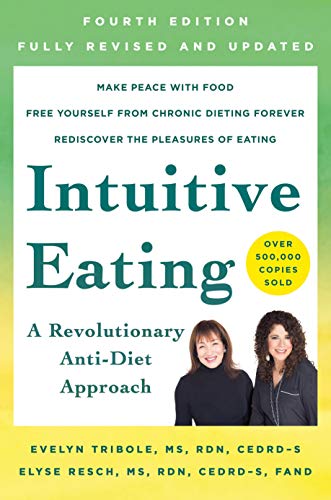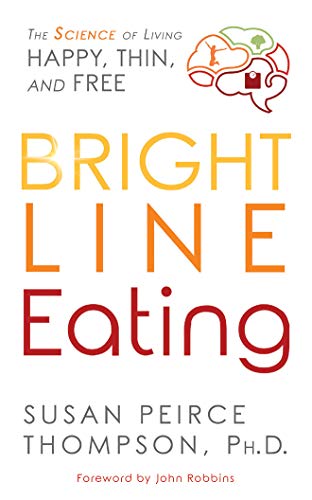Everywhere around the world nutrient deficiency is a scary reality. It can lead to a wide variety of unpleasant symptoms, including binge eating, and in some cases it can even be deadly.
Nutritional deficiencies happen when you have too little food and simply cannot get the vitamins your body needs from the foods you eat. For example, an estimated 44 % of preschool children in Africa are at risk for vitamin A deficiency. In Ethiopia, vitamin A deficiency leads to 80,000 deaths a year and affects 61% of preschool children.
However, the opposite is true as well.
You can have access and privilege to food. Yet if you eat too much food but it is empty of nutrients then you will have nutrient deficiencies as well. Because not all foods are created equal. If you binge French Fries all day everyday you’ll have the same vitamin A deficiency as if you hadn’t any access to food at all.
What most people don’t realize is you can have nutrient deficiencies despite eating too much food. In this post we’re going to clarify why, and what you can do about it.
We’re going to focus specifically on nutritional deficiencies for people who eat too much, and find themselves in the Binge-Restrict Cycle.
I know being in this cycle can be embarrassing to talk or think about, but please know these problems are extremely common. Binge eating impacts around 3% of the population (in developed countries), not least because we humans evolved to wolf down food when available because for most of human history food was scarce and starvation common.
Yet nowadays convenient, processed food that is empty of nutrients is everywhere and practically shoved down your throat. Instead of too little food, we have too much food. When you also have a sedentary, stressful career then you have a recipe for nutrient deficiencies and out of control eating.
What is the Binge-Restrict Cycle?
The Binge-Restrict Cycle is a pattern of dietary behavior that can lead to serious health consequences.
- It typically begins with a period of restrictive dieting, during which an individual restricts their intake of certain foods or food groups. Restriction can also be seen in work addiction, caregiving, hyper productivity, exercise and more.
- This restriction leads to feelings of deprivation, which can eventually lead to binge eating. Deprivation includes hunger, feeling burned out, feeling exhausted, and needing to shut down.
- Binge eating follows deprivation and is marked by episodes of overeating, often to the point of discomfort or pain. Binge eating while harmful overall does provide important emotional relief for the person who cannot stop bingeing, such as turning off your mind, making you be lazy to stop working, and making you stop care (if you’re a people pleaser).
- After a binge, the individual may feel guilty and ashamed, and may attempt to compensate for the calories consumed by severely restricting their diet again.
- This cycle can repeat itself multiple times, and can lead to serious medical problems such as obesity, diabetes, and eating disorders.
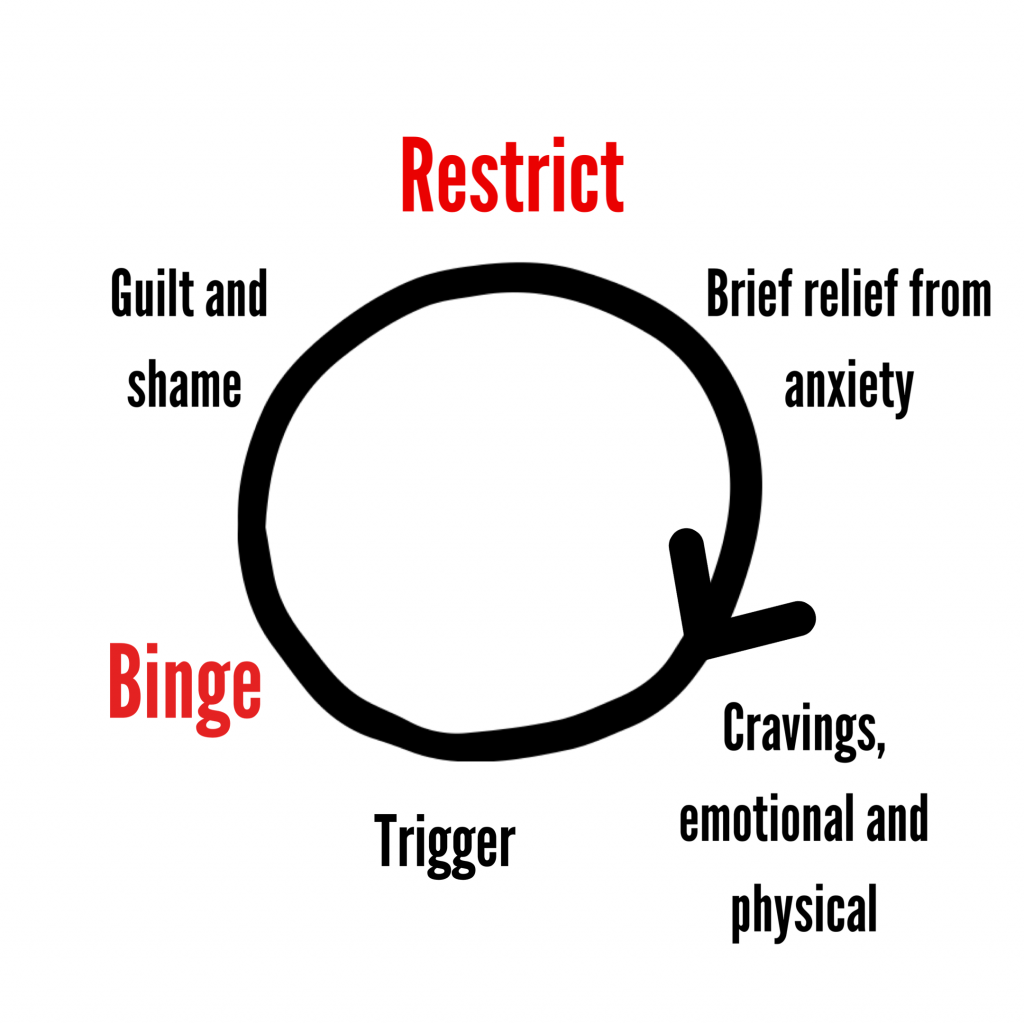
If you want to dive into more details, please watch my in-depth video on the Binge-Restrict Cycle or read my comprehensive post on the Binge-Restrict Cycle.
For purposes of this article, we first are going to focus on the deprivation from a nutritional standpoint. Of course emotions and mental health play a big role in our food relationships. However, in this article we’re just sticking with the foundations of food.
Binge Eating and Nutrient Deficiency
Most people know that nutrient deficiencies can cause a wide variety of health problems, like bone pain from a calcium deficiency or seasonal depression from a vitamin D deficiency.
Often we think of nutrient deficiencies in terms of people who do not have access to food. For example, every year 3.1 million children around the world die because they experience common nutrient deficiencies like iron deficiency.
However, many people don’t realize that binge and emotional eating can also cause these common nutritional deficiencies.
Yet, most people who overeat mistakenly think they need to eat less food.
Yet despite eating too much food, overeaters face many of the same problems as people who are starving to death.
This is because when the body isn’t getting the nutrients it needs, it starts to crave high-calorie foods in an attempt to get those nutrients.
And since most processed foods that people compulsively overeat are nutrient-poor, they provide no real nutritional value and only contribute to the cycle of binge eating.
Paradoxically, most people who overeat actually need to have a goal to eat more food during the day. Not the empty calories mind you, but more of the nutritous stuff. We’ll talk more about this later.
How You Can Be Nutrient Deprived Even While Eating Too Much
A lot of people think that the only way you can be nutrient deprived is by not eating enough food.
However, that’s not always the case. There are several ways you can be nutrient deprived, even while eating too much overall. Here are a few examples:
1. Skipping meals because you’re too full from a binge
If you’ve ever overeaten to the point of feeling sick, you know that the last thing you want to do the next day is eat anything. So, you skip breakfast, lunch, and maybe even dinner. The problem with this is that your body isn’t getting the nutrients it needs to function properly.
Plus, when you do finally eat again, you’re likely to overeat because by then you’re so famished. It’s a never-ending cycle that can lead to serious nutrient deficiencies.
We’ll talk more below about blood sugar levels because many people think that blood sugar swings wildly when your body did get way too many calories the night before.
However, blood sugar levels are not tied directly to how full you feel from the food you ate last night. If more than 5 hours have passed since you binged or overate, you may still feel mentally guilty and your stomach can feel bloated, but since time has passed since you ate your blood sugar levels are back to zero.
2. Mindless snacking and grazing throughout the day
If you find yourself snacking mindlessly or grazing throughout the day, you may be doing your body more harm than good. While it’s important to eat regular, nutritious meals to keep your metabolism going, constantly grazing can actually lead to nutrient deficiencies. That’s because when you’re constantly eating high-calorie but low-nutrient foods, you quell your hunger but you don’t fill your body up with nutrients.
For example, let’s say you have a bag of chips and some cookies as you walk by your desk shortly after lunch. Now that you’ve had these calories you won’t be hungry, but you also won’t be satisfied either because these simple carbs don’t have any nutrients or fiber.
Over time, this can lead to deficiencies in vitamins and minerals, as well as other health problems. So if you’re grazing all day long, take a step back and reassess your eating habits. Your body will thank you for it!
Even if you’re eating healthy snacks!
You really want to shoot for a feeling of satisfaction and feeling content in your stomach. This feels grounded, calm, soothing, stable. Healthy snacks can be fine but generally speaking you’ll feel more satisfied if you enter the meal gently hungry.
3. Eating processed foods instead of nutrient-rich foods
Just because you’re eating a lot doesn’t mean you’re getting enough nutrients. If you’re eating mostly processed foods, your body isn’t getting the vitamins, minerals, and antioxidants it needs to function properly. Over time, this can lead to serious health problems like heart disease and cancer.
Overall, there are several ways you can be nutrient deprived, even while eating too much food. So, if you’re skipping meals because you’re too full from a binge, or not noticing your hunger levels due to stress or distractions, or eating mostly processed foods, make sure to get more nutrient-rich foods into your diet so your body can function properly.
How Low Blood Sugar Causes Ravenous Hunger Even If You Don’t Feel Hungry
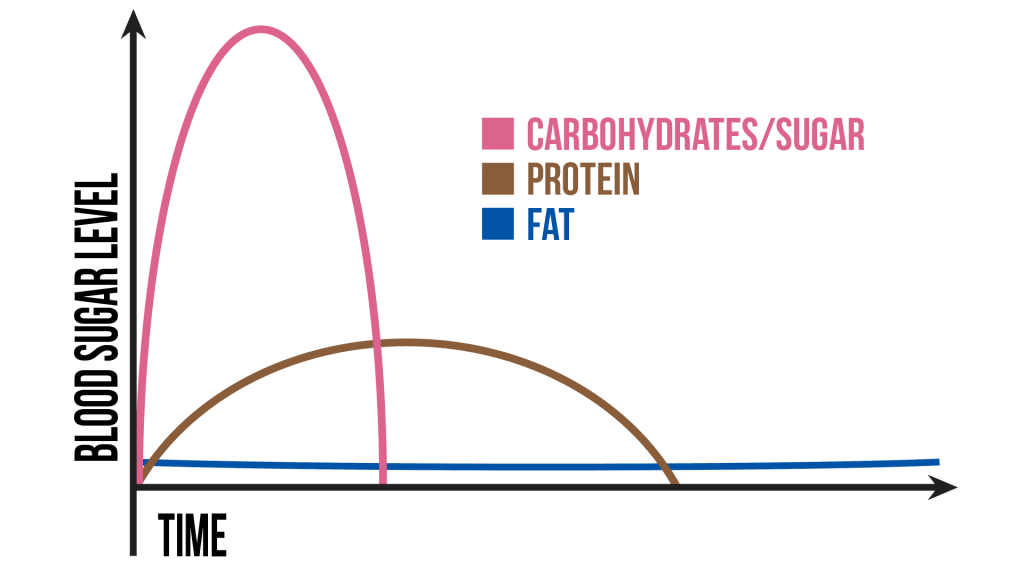
Our brains are designed to keep us alive, and one of the ways they do that is by triggering hunger when our blood sugar gets low. This is because, historically, food was scarce and our ancestors needed to be able to find calories quickly in order to survive.
Even though we now live in a world where food is much more abundant, our brains still react the same way to low blood sugar.
When our blood sugar dips, the part of the brain responsible for eating (the amygdala) kicks into gear and tells us we need to eat. This can happen even if we don’t feel hungry consciously.
Your stomach may even remember the stretching sensation from eating too much food from last night. As a result, you may not feel like eating. If you also feel guilty and remorseful about your overeating, you will definitely want to skip breakfast and eat less.
Because even if your stomach is stretched, the food in your stomach gets digested after 6 hours and your blood sugar levels return back to normal.
This is why skipping or missing meals (especially breakfast or lunch) is part of the problem. While you may not feel like eating, your blood sugar levels tell a different story. If your blood sugar levels go too low as a result of missing meals, you’ll start the cycle over again.
It’s absolutely essential you continue to eat breakfast, even if you binged the night before. We’ll come back to breakfast later on this in this post too.
How Too Much Blood Sugar Blocks Hormones Responsible For Fullness
You might not realize it, but if you’re consuming too much sugar or empty carbs, you could be setting yourself up for some serious nutritional deficiencies. That’s because sugary foods and empty carbs are often devoid of the nutrients your body needs to function properly.
There are a few different ways that consuming too much sugar can lead to nutritional deficiencies. Here’s a closer look at how each of these factors contributes to nutritional deficiencies:
- Impaired nutrient absorption: Sugar can interfere with the way your body absorbs other nutrients. Sugar can bind to other nutrients in the gastrointestinal tract and prevent them from being absorbed into the red blood cells. One common example is the hormone leptin.
- Displacement of nutrient-rich foods: Sugary foods tend to be high in calories but low in nutrients. When these foods make up a large portion of your diet, it can crowd out other more nutrient-dense options like fruits, vegetables, and whole grains. As a result, you may not be getting enough vitamins, minerals, and fiber.
How Sugar Blocks Leptin So You Don’t Feel Full
As most of us know, too much sugar is not good for our health. But did you know that sugar can actually block the hormones that make us feel full? That’s right—sugar can interfere with the signals our body sends to our brain telling us to stop eating. As a result, we may end up eating more than we should, leading to weight gain. Let’s take a closer look at how this happens.
One of the hormones that plays a role in making us feel full is leptin. Leptin is responsible for sending signals to the brain informing us that we have had enough to eat and can stop now.
However, leptin resistance, insulin resistance as also known, can occur when the body becomes insensitive to leptin’s signals. This can lead to overeating and weight gain.
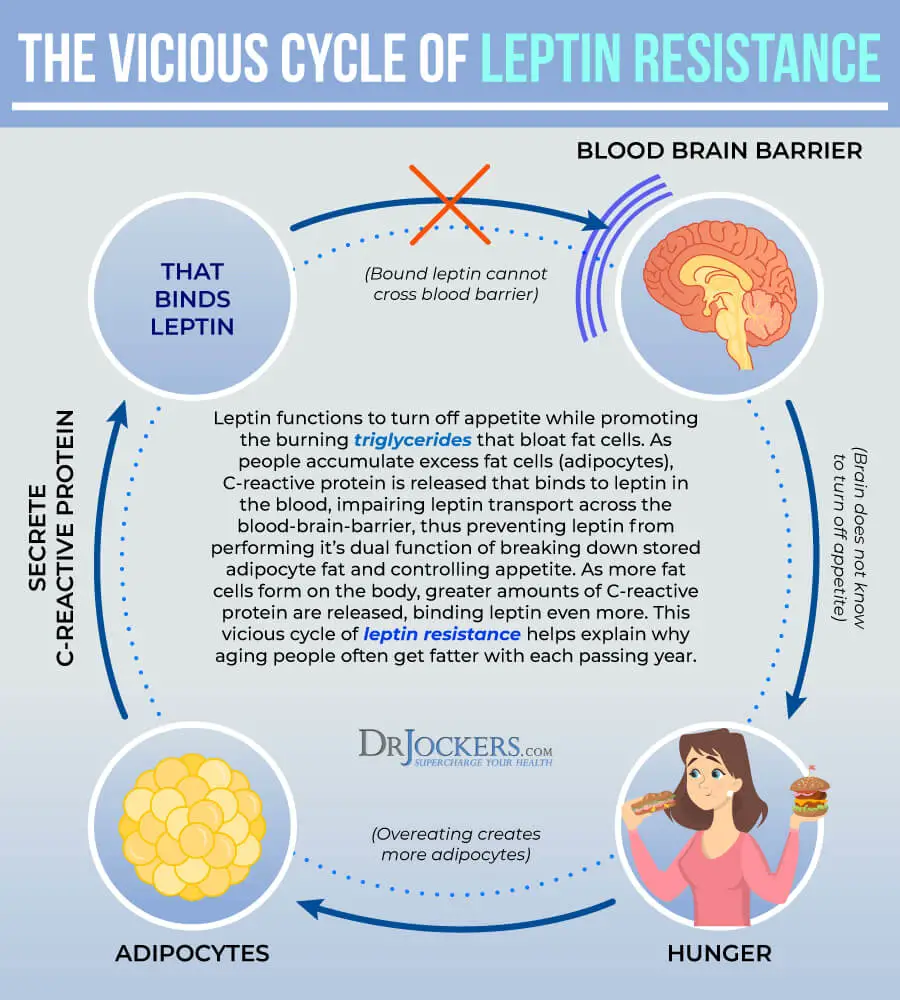
How does leptin / insulin resistance occur?
When we consume too much sugar, our body releases insulin to reduce our sugar levels.
Insulin is the hormone that helps regulate blood sugar levels in the body. When functioning properly, it tells the body when to absorb sugar and when to store it for later use.
Yet insulin is precisely the chemical that blocks leptin.
Unfortunately because of the modern sugary diet, our insulin levels are elevated too frequently, which leads to leptin being resistant to the insulin.
Essentially, when we eat too much sugar, our baseline levels of insulin become too high, and the leptin gets blocked from entering our brain stem.
Instead of getting the signal that we are full, our brain continues to receive messages telling us to eat more and more.
A number of factors also can contribute to insulin resistance, including inflammation and genetics. While there is no cure for leptin resistance, there are ways to manage it.
Treatment typically focuses on lifestyle changes, such as eating a healthy diet and exercising regularly. In some cases, medication may also be necessary.
Please see: 6 Best Supplements for Insulin Resistance
Leptin resistance is a complex condition, but with careful management, it can be more effectively controlled.
Summary So Far – Big Picture Nutrient Deficiency For Food Addicts, Overeaters and Binge & Emotional Eating
- If you’re a food addict, overeater, or binge eater, you may miss meals (or eat too clean) in an effort to lose weight. Or, you may want to be productive and accomplish a lot in order to make guilt go away – so you forget about eating because you’re stressed. However, missing meals in any situation can actually cause more harm than good – even if you are eating too many calories in general.
- When you eat too many empty calories, your body gets deprived of nutrients. So even though you’ve eaten too many calories and the natural response is to eat less, those calories didn’t give you any nutrition so you still need to eat. Missing meals is NOT the answer. It’s a core problem causing nutritional deficiencies.
- Plus, when you miss too many meals your blood sugar levels drop. This triggers your amygdala—the part of your brain responsible for the fight-or-flight response—to think you’re starving. As a result, you’re more likely to overeat or binge on sugary foods. Again!
- Over-consuming sugary foods leads to higher insulin levels, and higher insulin in your blood blocks the hormone leptin. Leptin is the hormone responsible for feeling full, but now it’s blocked due to all the sugar.
- So you never feel satisfied. You’re hungry even after just eating. You continue eating past the point of fullness (because leptin is blocked). The only physical signal your body gives you to stop eating is now the bloated pain in your belly after bingeing. You’ve lost connection to your hunger and fullness signals.
- This pain gets remembered by your body and makes you feel shame and guilt. So you don’t feel like eating the next day because your stomach was stretched and you’re wanting to make the shame and guilt go away by being productive, or sticking to “healthy” eating which is often not enough fuel for your body.
- But now that you’re under-eating the next day, whether due to being too busy, too little food, or just plain out restricting, you have increased risk for the cycle to repeat the next evening or a few days down the line. You’re nutrient deficient, your blood sugar levels are low, and now you’re back with food cravings – despite eating too much already in general.
- Again, again, again and again.
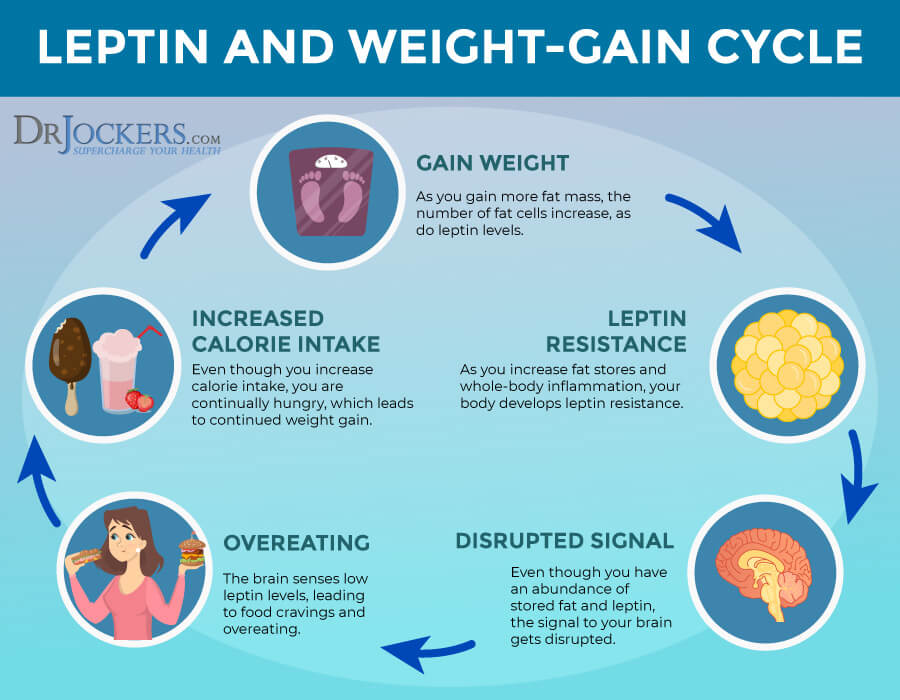
Notice how Binge-Restrict Cycle from above mirrors the cycle of Leptin / insulin resistance?
It’s because nutritional deficiencies are related to both of these health struggles!
Fortunately, there are straightforward steps for nutritional deficiencies that you can understand and implement today!
But, what are the right meal plan principles for you personally to follow?
There are so many diets out there, how can you be sure that you’re picking one backed by science, and that will actually work for you?
Discover Universal Principles to Meal Planning By Studying Abstinence Versus Intuitive Eating
Hegel, one of the most famous philosophers in the world, is known for his thesis, antithesis, and synthesis philosophy.
His philosophy of thesis, antithesis, and synthesis has been famous in philosophy circles for about two centuries. For more information about Hegel, you may read this Stanford article about Hegel’s Dialectics.
The basic premise is that an initial idea (thesis) leads to generating its opposite (antithesis), which in turn leads to proposing a new and more nuanced idea (synthesis). This process of reasoning can be applied to any number of fields, from the natural sciences to theology – and yes, even to meal planning.
In each case, the goal is to arrive at a more comprehensive understanding of the topic at hand. The three elements of thesis, antithesis, and synthesis are often represented as a triangle, with each point representing a stage in the logical progression from one idea to the next.
The philosophy of thesis, antithesis, and synthesis is a powerful tool for understanding how to address the Binge-Restrict Cycle and Leptin resistance and to do something I like calling “good enough” meal planning.
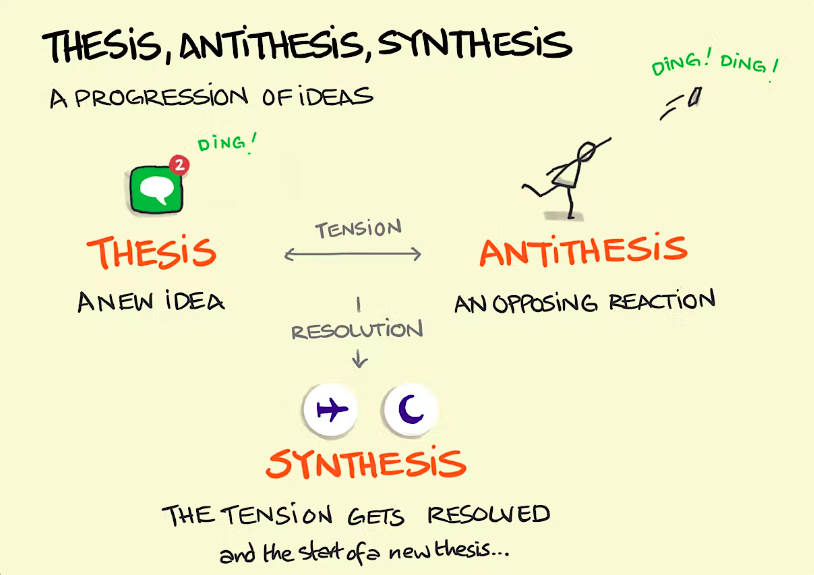
Why Binge-Restrict Cycle Occurs – Abstinence Versus Intuitive Eating
If you’ve ever read about The Binge-Restrict Cycle, you’ll see that everyone agrees on the problem at the behavioral level.
That is, everyone can see the pattern of restriction, deprivation, cravings, bingeing, guilt and shame, and the cycle beginning anew.
However, people disagree about what causes the problem, and they seemingly disagree on how to solve the problem.
The two “thesis-antithesis” positions we’ll examine now are Intuitive Eating and Bright Line.
Let’s examine two different approaches to reducing nutrient deficiencies, overcoming the Binge-Restrict Cycle, and eating sustainably and healthily.
If we can see what two, distinct sets of approaches have in common regarding the solution to this problem, then we’ll be “in the middle” and have balance.
We’ll have a synthesis.
Remember – first, we must understand a thesis (what causes Binge-Restrict Cycle according to Intuitive Eating). Then we need to understand it’s antithesis (what causes Binge-Restrict Cycle according to Bright Line).
In the rest of this section, we’ll talk about a thesis from Intuitive Eating and its relatives, and its antithesis from Bright Line and its relatives.
Then in the following section, we’ll dive into their commonalities – the synthesis.
What causes the Binge-Restrict Cycle problem?
Intuitive Eating and related approaches like Health At Every Size, Anti Diet, and many others believe deprivation is the core cause of Binge-Restrict Cycle.
In contrast, Overeaters Anonymous Programs and related approaches like Bright Line, GAPS, etc., believe that processed chemicals combined with genetic susceptibility explain symptoms of food addiction and the Binge-Restrict Cycle (like weight gain, fatigue, compromised immune system, etc).
Let’s explore how these fit the thesis-antithesis model.
- Thesis – Intuitive Eating believes the Binge-Restrict Cycle is caused by nutritional and emotional deprivation. Their solution is seemingly to give yourself unconditional permission to eat.
This is illustrated by the following quote from Elyse Resch and Evelyn Tribole’s book, “Intuitive Eating 4th Edition: A Revolutionary Anti-Diet Approach”, regarding its principle known as “Unconditional Eating”:
“Call a truce; stop the food fight! Give yourself unconditional permission to eat. If you tell yourself that you can’t or shouldn’t have a particular food, it can lead to intense feelings of deprivation that build into uncontrollable cravings and, often, bingeing. When you finally “give in” to your forbidden foods, eating will be experienced with such intensity it usually results in Last Supper overeating and overwhelming guilt.”
Many programs similar to Intuitive Eating believe the same thing, i.e., that deprivation is the root cause.
- Antithesis – In contrast, Overeaters Anonymous Programs, Bright Line, and others tend to believe the Binge-Restrict Cycle is caused by food addiction. These programs take an abstinence approach, similar to the abstinence from alcohol in Alcoholics Anonymous programs. In particular, their solution is to abstain from all sugar and flour.
This is illustrated by the following quote from Susan Pierce Thompson’s book, “Bright Line Eating”, regarding its principle known as “No Sugar”.
“Sugar – This is really the cardinal Bright Line. Without it, none of the others are effective, because you have to take sugar out of the equation to allow the brain—and therefore the body—to heal. To be clear, by sugar I mean all ADDED sugar. Any food containing any of these ingredients has to be eliminated because all refined forms of fructose and glucose hit our insulin system harder than our bodies were designed to withstand. Elevated baseline insulin levels then block leptin, leading to insatiable hunger and sedentary behavior. And the sugar pounds our dopamine receptors, leading to down regulation and overpowering cravings.”
Likewise, many similar programs like Overeaters Anonymous 90 believe the same thing, i.e., that processed foods and genetic susceptibility are the root cause.
So we have thesis and antithesis. See how these different responses are the opposite, that is, one is thesis and then antithesis (and vice versa): Unconditional Eating = Opposite of Abstinence; Abstinence = Opposite of Unconditional Eating.
Now we can proceed to see the “synthesis” – how these approaches have more in common than you may think!
What Intuitive Eating and Overeaters Anonymous/Bright Line Approaches Have In Common
Despite different advocates believing in different causes of the Binge-Restrict Cycle (deprivation versus chemical addiction and genetics) and recommending different solutions, we can still see incredible similarities between these two approaches, especially in regards to the “basics of eating food” and having regular meals.
Whether you tend towards one or the other approach, understanding the commonalities between the Intuitive Eating and the Overeaters Anonymous/Bright Line approaches can give you confidence that no matter what path you’re pursuing, everyone is in agreement with some fundamental principles.
In this section, I’m going to share snippets from the Intuitive Eating book and compare them with snippets from the Bright Line book.
If you want to see more books I’ve read and recommend about binge eating, please read: 10 Best Binge Eating Books.
I’m certain that with all these different approaches, you’ll actually find much in common, especially in regards to eating regular meals!
This can be a big relief, because for many people the idea of having to choose between two plans of ‘how to eat correctly’ can induce a panic attack!
Now you have a set of meal principles that are near-universal. Because if these extreme, opposite approaches both recommend these principles, then you know you stand on solid, rational, scientific ground.
Instead, with great delight, I share with you the powerful principles these plans both have in common!
After reading these snippets and determining what principles they have in common, then in the next section we’ll introduce the synthesis – Universal Basic Meal Plan – and following that we’ll share basic tips and resources to create your own meal plan.
Let’s dive in!
Comparison of Snippets From Intuitive Eating “Versus” Bright Line About Meal Plans, Hunger, and Nutrient Deficiency
Remember our thesis + antithesis = synthesis?
- Thesis – Intuitive Eating and related approaches like Health At Every Size, Anti Diet, and many others believe deprivation is the core cause of Binge-Restrict Cycle. This approach advocates for “unconditional eating”.
- Antithesis – Overeaters Anonymous Programs and related approaches like Bright Line, GAPS, etc., believe that processed chemicals lead to food addiction and cause the Binge-Diet Cycle for people who are genetically susceptible. This approach advocates for abstinence, especially from sugar.
Remember, the key is to keep your mind open to each perspective. I am here to share with you what they have in common.
They have a lot more in common than you may think!
I am not asking you to change any of your beliefs. Just to keep an open mind, and be prepared to see the powerful principles these two belief systems have in common!
Commonality #1 – Eat Regularly
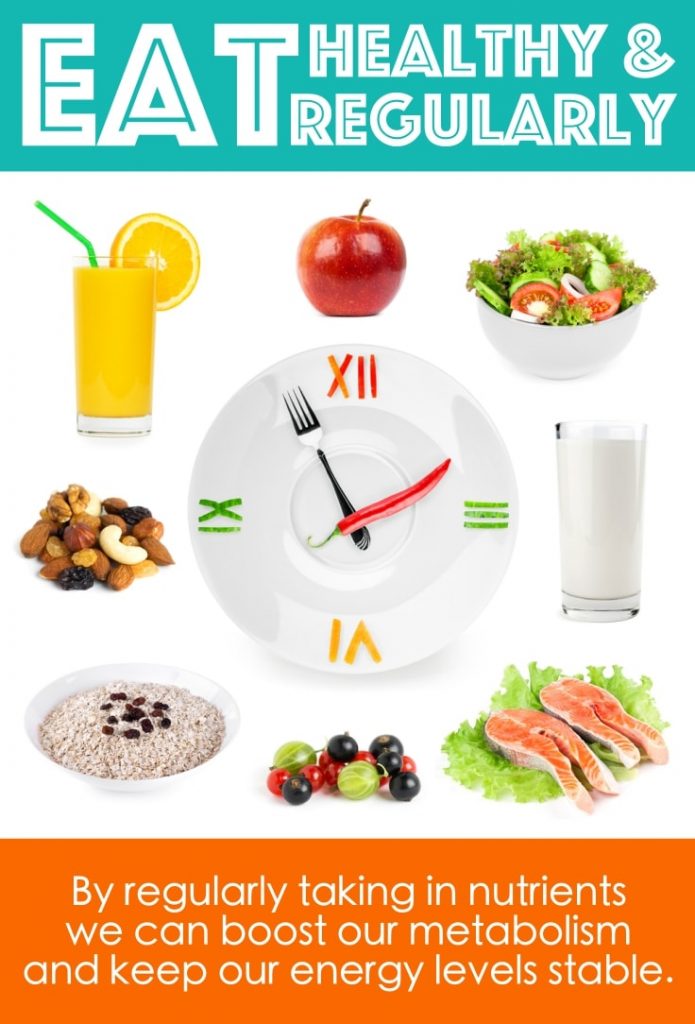
Intuitive Eating
Whether or not you can readily gauge your hunger levels, Intuitive Eating’s general guideline is to go no longer than about 4-6 waking hours without eating.
The Intuitive Eating book states, “This is based on the biology of fueling up your carbohydrate tank in the liver, which runs out every three to six hours. I have observed that clients who go longer than five hours without eating tend to overeat at the next eating opportunity. (For some people, this can happen even after three or four hours without eating.)”
Bright Line
Overeaters Anonymous and Bright Line similarly focus on not going too long without eating, in this case by setting a very regular eating schedule.
The Bright Line book states “When regular meals become part of the scaffolding of your life, it takes the burden off willpower. A lot. When you set up a schedule of eating three meals a day at regular meal times-breakfast at breakfast time, lunch at lunchtime, and dinner at dinnertime-not only does eating the right things become automatic, but passing up the wrong things in between.”
“Try to eat breakfast at breakfast time, lunch at lunchtime, and dinner at dinner time, and to try to space your meals four to six hours apart. In other words, try not to eat your next meal sooner than four hours after the last meal and try not to wait longer than six hours.”
“I [Susan Pierce Thompson, author of Bright Line] do want to say, though, that this isn’t a Bright Line. This is just a guideline. There are times when I eat my next meal sooner than four hours and there are times when I find I have to spread my meals out farther than six hours. Life happens sometimes. But in general, the four-to-six hour rule is a good guideline.
“One of the benefits of waiting at least four hours between meals is that you will have digested your food from the previous meal more thoroughly. If you eat sooner than four hours, you might not have finished digesting the majority of your food, and it’s better for the digestive system if you clear out the bulk of the previous meal before adding more.”
Commonality #2 – Eat Mindfully
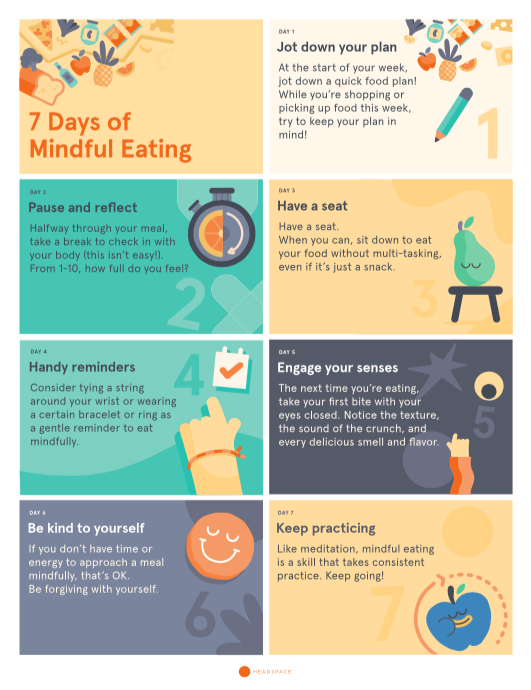
Both Intuitive Eating and Bright Line include various recommendations and tips to eat your food mindfully. Let’s see what those look like.
Intuitive Eating
“People who come home and drop on the sofa with a box of crackers and a soda often find themselves getting up at each commercial for yet another snack. They feel that they haven’t really eaten and never seem to get satisfied. By the end of the evening, they feel overfull and frustrated.
These people typically are focused on every aspect of food except the here and now. They lament the past and worry about the future (what will I eat, how will I work off these calories), but very rarely do they focus on the actual experience of eating. Therefore they are not tasting—not experiencing or savoring food.
It’s almost as if the art of eating needs to be relearned without bias. And mindful eating is a great way to do this:
- Make time to appreciate your food. Give yourself a distinct time allowance for a meal. Even fifteen minutes is better than nothing.
- Sit down at the table or your desk. Standing at the refrigerator or walking around decreases attention and satisfaction.
- Take several deep breaths before you begin to eat. Deep breathing helps to calm and center you, so you can be focused on eating slowly.
- Pay attention to eating as slowly as you can. Remember that your taste buds are on your tongue, not in your stomach. Gobbling your food takes away your chance to really taste it.
- Taste each bite of food that you put in your mouth. Experience the different taste and texture sensations that the food can provide.
- Put your fork down, now and then, throughout the meal. This will help to slow you down. Take a time-out in the midst of the meal to check your fullness level (see Chapter 9). Food won’t taste as good or be as satisfying after you’ve reached the last-bite threshold.
- Finally, remember the three “S’s” of satisfying eating: eat Slowly, eat Sensually, and Savor every bite.
Bright Line
Now let’s look at what the Bright Line book says about being mindful:
“As a culture, we have lost the concept of real meals. We graze all day. There is no time of day now when food is not on offer. And, if you or your loved ones are prone to food addiction, like those sign-tracking rats, this means that your whole day has become one long series of magnetic cues that pull you in and result in food going into your mouth without you necessarily even being aware of it. In short, if you allow yourself to mindlessly eat between meals, you’re sunk. You’ll never get thin that way. Or happy or free, for that matter.”
“Eating while seated is important. There, on your table, you set out the food you’ve planned to eat. It does not happen in your car, on the sidelines of soccer games, at the movies, or on your couch. It is time to eat when you’re at the table. By shifting the cues your body uses to recognize acceptable times for consuming food, you shift them away from everything else that used to trigger you.”
“Lunch may have to be at your desk, but this can work if you eat at a set time every day.”
“Again, I ask you to be mindful. Turn off your computer. Maybe give thanks. The same for dinner. Consider weaning yourself off of the habit of eating dinner in front of the TV. Entertainment can be a cue to relax, or to share a laugh or cry with friends and family, but it shouldn’t be a cue to eat.”
Commonality #3 – Eat A Variety of Nutritious Foods
Both Intuitive Eating and Bright Line advocate eating mostly veggies, some grains, plenty of protein and some healthy fat.
While Bright Line does offer lists of foods with various measurements, Intuitive Eating does not offer those measurements. As this is not a point of similarity I am not including the lists of measurements of foods that Bright Line provides. However, please rest assured knowing the foods listed by Intuitive Eating are the same foods listed as Bright Line. The only difference is that Bright Line provides quantities and Intuitive Eating does not.
Here’s some more detail, particularly from Intuitive Eating, on eating a variety of nutritious foods.
Intuitive Eating
“There’s a useful tool that extends to principle #10 for “gentle nutrition” for meals. Visualize your plate as a lopsided peace sign (see figure below). As you can see, the plate is mainly filled with carbohydrate-rich foods (grains, fruits, and vegetables). This tool serves two purposes. First it gives you an easy-to-remember guide for healthy eating, and second it helps to serve as a reminder to keep the peace with food. Remember, this is just a guide, not a rigid edict. There are days when your intuitive signals send you to a different balance of foods than is on this diagram.
The overall guideline is that, generally, the less a food is processed, the more nutrients are retained, and less sodium and sugar are added. If possible, choose the following types of foods to eat more often:
- Nutrient dense foods – these foods naturally provide more nutrients per bite. These include: whole grains, beans, fish, avocado, nuts, and calcium-rich foods such as milk, cheese, yogurt, and calcium-fortified soy milk.
- Protein-rich foods – eat a variety of these foods. They include beans, seafood, chicken, turkey, nuts, and lean meats, eggs, fatty fish, and dairy products. In addition to its role in building and maintaining muscles and hormones, protein helps provide a feeling of fullness. Protein is essential for preventing muscle cramps, muscle aches, muscle weakness, and the healthy growth of your skin and organs.
- Quality fats – fat is also a nutrient, required by the body. The brain is made up of mostly fat and functions best with omega-3 fats, which are found in seafood, fish oil, algae, and seaweed. Other quality fats include: olive oil, avocado, nuts, seeds, flaxseed oil, and canola oil. And for satisfaction purposes, fat is the molecule that gives flavor to foods and promotes satiety.
- Whole foods – these are the unprocessed foods, which are high in fiber and include, for example: brown rice, oatmeal, millet, beans, quinoa, fresh fruits, and vegetables.
Bright Line
Here is Bright Line’s Meal Plan:
Breakfast:
- 1 breakfast grain
- 1 fruit
- 1 protein
Lunch:
- 6 oz. vegetables
- 1 fruit
- 1 fat
- 1 protein
Dinner:
- 6 oz. vegetables
- 8 oz. salad
- 1 fat
Notice the similarities? There’s grains, veggies, proteins, fruits and fat!
When you sit down to eat, don’t just eat grains or carbs. That’s fine to have some. But if you just have muffins without protein, healthy fats, veggies or fruits then you’ll be going astray.
Have a variety of nutritious foods when you eat!
SYNTHESIS: Universal Basic Meal Plan Principles – A Common Ground Starting Point on How to Heal Your Relationship with Food
Now, finally, let’s get to the synthesis portion of the thesis-antithesis-synthesis philosophical model!!
Many of us have a complicated relationship with food. We either love it or we hate it, and there doesn’t seem to be any middle ground. We can become obsessed with what we’re eating, or we can distance ourselves from food altogether. Neither approach is healthy in the long run.
Unfortunately, many people feel confused about how to get started and what to eat. Each diet, eating plan and approach seems to offer unique “solutions” although (as we explored above), there are some commonalities.
Thankfully, there is a way to develop a healthy, balanced relationship with food. It’s called the Universal Basic Meal Plan, and it’s a combination of Intuitive Eating and Overeaters Anonymous/Bright Line approaches.
YES, SYNTHESIS!!
The Universal Basic Meal Plan Principles use what all of these approaches have in common. That way you can start following a meal structure without any internal conflict or confusion. Because these are literally the same to every dietary approach!
The UBMP has three simple principles:
- Eat regularly each day
- Eat mindfully
- Eat a variety of food groups when you eat – such as protein, fat, veggies, grain, fruit each day
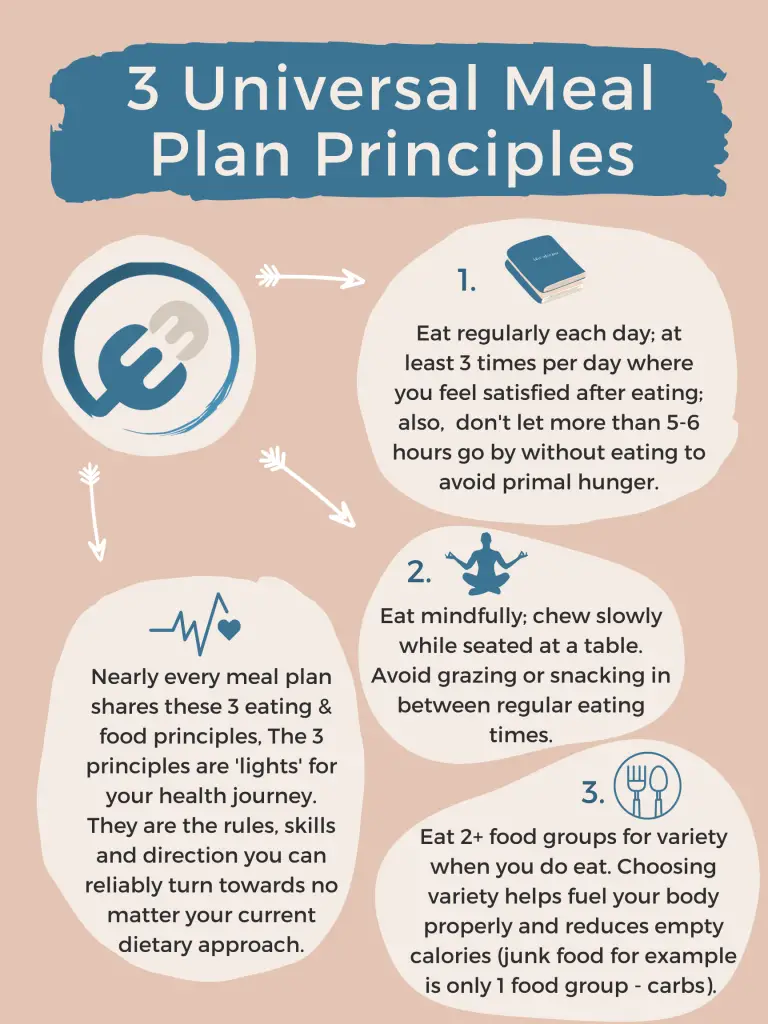
Let’s take a closer look at each of these principles and see how we can put them into practice in our own lives.
1. Eat Regularly Each Day 4-6 Hours
The first principle of the UBMP is to eat regularly each day 4-6 hours. This may seem like a lot, but it’s actually not as difficult as it sounds. All you need to do is plan ahead and make sure you have healthy snacks on hand so you’re not tempted to eat junk food when hunger strikes.
Please note various meal plans will give times. For example, intermittent fasting or keto may advocate for eating within an 8 hour period while a dietitian will advise you to eat breakfast, lunch, a snack, and then dinner.
Which one is right? Keto or a dietitian?
Well, now you see the common synthesis. As long as you’re eating regularly a few times each day, you’re on the right track. The overall goal is to avoid ravenous hunger, fuel your body with adequate nutrients.
This means first and foremost, you do not go too long without food.
If you go too long without food to lose weight, your body strips away your muscle as well. You need to eat regularly, nutritiously, and satisfactorily filling even if you are trying to lose weight.
This principle of Eating Regularly, is the hallmark teaching of renowned dietitian, Nancy Clark. I interviewed Nancy on my podcast, Eating Enlightenment. Her book Nancy Clark’s Sports Nutrition Guidebook has sold over 750,000 copies.
2. Eat Mindfully
The second principle of the UBMP is to eat mindfully. This means sitting down at a table and savoring your food slowly. It may seem like a small thing, but eating mindfully can have a big impact on your relationship with food. When you eat mindfully, you’re more likely to appreciate the taste and nutrition of your food, and you’re less likely to overeat. Other important things to consider are chewing slowly and sensually, while minimizing distractions.
3. Eat Food Group Variety – Such as Protein, Fat, Veggies, Grain, Fruit Each Day
The third principle of the UBMP is to eat a variety of food groups – such as protein, fat, veggies, grain, and fruit each day and when you eat. This is important because it ensures that you’re getting all the nutrients your body needs to prevent mineral deficiencies, iodine deficiency and any other common nutrient deficiencies like a Vitamin D deficiency.
If you only eat one type of food group, you’re missing out on essential nutrients that can only be found in other food groups.
If you’re ready to heal your relationship with food, the Universal Basic Meal Plan is a great place to start. By following the three simple principles of eating regularly each day every 4-6 hours, eating mindfully, and eating food group variety – such as protein, fat, veggies, grain , and fruit each day – you can develop a healthy attitude towards food that will last a lifetime.
By following these 3 principles, you’ll also reduce nutrient deficiencies, and solve the nutritional deprivation that is making the Binge-Restrict Cycle fire!
Plus, if you ever get confused on which meal plan to follow, you’ll have this as your default.
Sure, it won’t solve all your questions or be perfect for every individual situation. But, now you have a solid blueprint that is ‘good enough’.
Practical Tips and Resources on Implementing the Universal Basic Meal Plan Principles
Remember our goal is a daily ritual – eat every 4-6 hours, eat mindfully, eat a variety of food.
This is what every meal plan has in common. Following a regular healthy meal plan is the best thing you can do for your weight, energy, body, heart, mood, and overall well being.
And be patient. Various studies show that it takes an average of 66 days to form a new habit, with a range of a few weeks to 8-9 months.
So it will take some time to make this daily ritual a natural habit you do effortlessly. Eventually you will adjust to new cues, routines and behaviors and this will become automatic.
To support you, here are some key tools.
Journal
If you are trying to stick to a specific meal plan, journaling can be a helpful tool.
- Writing out what you plan to eat the night before can help you to stay on track. You can print and use this Free Journal Template. You may also want to try the Eating Enlightenment paperback food journal.
- You can also keep a gratitude journal, in which you write down things you are thankful for each day. This can help to shift your focus from food to other aspects of your life. Sometimes people don’t want to journal about food so this can be a nice way to counter any body image, shame or guilt you may feel.
- Hunger tracking is another effective journaling technique. Before you eat, rate your hunger on a scale of 1-10. This will help you to become more aware of your eating patterns and make better choices about when and how much to eat. Our free Eating Enlightenment Food Journal app contains a hunger tracking tool.
- Finally, trigger analysis is a journaling technique that can help you to identify situations that lead to overeating. If you find yourself overeating in certain situations, jot down what was happening just before you started eating. Eventually you’ll see a pattern and this will help you to avoid these situations in the future.
- Want more journal training? See over 100+ real client examples and journaling technique training videos in my intro to mindful food journaling online course.
Journaling is a simple but powerful tool that can help you to stick to your meal plan and reach your nutrition goals.
Plus, journaling is very similar to meditation. Think about it.
- You pause.
- You are still.
- You are focused.
But the two skills are different from each other. If you are more drawn to practicing meditation, in addition to journaling or separately, that is a good place to start.
You may also want to just practice journaling, and not meditate. That’s fine too.
They are so similar to each other – yet different enough – that you’ll find your self drawn to one or the other.
Finally, be sure to know that you can adjust “how” you journal or meditate.
For example, here are some ways you can switch up your journaling to keep things interesting:
- 1 self-reflection journal entry at end of the day
- Mini journal entries tracking hunger at each meal
- If you feel like challenging yourself, try writing your primary emotion on paper before you eat for one day. Now that’s a challenge!
Whatever supports you in following the universal basic meal plan principles is the key!
Meal Planning
1 – Buy everything at once
Buying everything at once is pretty straightforward:
You buy everything at once instead of going to the store every other day.
If you spent one to two hours one day a week buying everything ahead of time, you would actually have more time during the week for other things you want to do.
Instead of spending 30 minutes a few times per day going to restaurants or ordering out, buying everything at once saves time.
Then you can actually plan to ensure that you have the food available for the week!
Please read: Best Meal Delivery Service for Sticking to Your Goals.
2 – Simple Combinations
Eating a variety of foods is essential to maintaining a healthy diet. But sometimes, it can be difficult to know what combinations of foods will give you the most nutritional bang for your buck. Never fear! We’ve compiled a list of simple food combinations that will help you get the nutrients your body needs to stay healthy and satisfied.
This will help you plan out your day ahead of time, or think quickly on the fly.
Two of my favorite combinations are fruit and yogurt, and peanut butter and bread.
Fruit and Yogurt: This combination is a great source of protein, calcium, and probiotics. Probiotics are live bacteria that are good for gut health. Adding fruit to your yogurt will also give you some extra fiber. Plus the fruit has vitamin C as well 🙂
Peanut butter and whole wheat bread is a simple and common combination that can help you achieve the principle of variety in your diet. Peanut butter is a good source of healthy fat, protein, and vitamins and minerals (such as vitamin E, magnesium, and potassium), while whole wheat bread provides complex carbohydrates, fiber, and other nutrients. This combination can help you feel satisfied after eating and provide you with the energy you need to get through your day.
By including simple combinations in your meal planning, you can ensure that you are getting the nutrients your body needs while also practicing variety. For pregnant women, then eating a variety of iron rich foods will help you in preventing anemia (low blood iron levels). As a result, you will be more likely to stick to your diet and reach your goals.
Let’s look at some more simple combinations using different nutritious ingredients. And if you buy all these ingredients at once at the store, then you can prepare different combinations and plan out your week ahead of time.
Here’s a list of nutritious ingredients:
- Brown rice
- Whole wheat bread
- Vegetables
- Oats
- Spinach
- Chicken
- Ground beef
- Beans (canned)
- Eggs
- Nuts
- Olive oil
- Yogurt
- Peanut butter
- Whole grain cereal
Let’s look at a few examples about how to combine some of these ingredients to create different delicious meals.
For example, one day I can have:
- Breakfast: bread + eggs + milk
- Lunch: spinach + olive oil / nuts + chicken
- Snack: bread + peanut butter
- Dinner: brown rice + ground beef + beans
Next day I can have:
- Breakfast: oats + nuts + yogurt, or whole grain fortified cereals and milk
- Lunch: brown rice + beef + eggs
- Dinner: beans + veggies w/ olive oil + nuts
- Snack: yogurt + peanut butter
If you don’t have time for this, you may want to consider a meal kit delivery service.
3 – Getting Your Veggies
From the book Intuitive Eating, “one problem with chronic dieters is that they’ve been “vegged out.” For example, nearly every diet regimen prescribed celery and carrot sticks as the safe and approved snack of choice.
If that’s your case, ask yourself how you can incorporate vegetables (and fruit) in a manner that’s pleasing and does not smack of a weight loss diet.”
A diet rich in dark green vegetables is best for the digestive tract of pregnant women too as key vitamins such as folic acid are found in veggies.
Think of possible ways in which you can eat fruits and vegetables as a built-in component to a meal, such as:
- Vegetable lasagna
- Add grated carrots to a favorite pasta sauce
- Ratatouille
- Potato cakes spiced with various chopped vegetables
- Stir-fried vegetables on rice
- Stuffed baked squash
- Stuffed peppers
- Stuffed baked potatoes
- Fajitas (they’re usually loaded with vitamin-rich peppers)
- Pancakes topped with a fresh fruit
- medley
- Fruit compote
- Fruit smoothie
Snack Ideas To Go
This is part of the simple combination idea. If you’re looking for some easy and healthy snack ideas to take on the go, you’ve come to the right place. Here are a few of our favorites:
Fruit is always a good choice, and it doesn’t have to be boring. Mix up your routine by trying new fruits or adding them to other snacks. For example, slices of apple or pear make a great addition to a peanut butter and jelly sandwich.
Vegetables can be just as delicious as fruit, and they offer different nutrients and benefits. Try carrot sticks, bell peppers or celery with your favorite dip, or pack a small salad to munch on throughout the day. If you’re looking for something heartier, roasted veggies make a great portable snack. Just roast them ahead of time and store them in an airtight container. Then, when you’re ready to eat, just reheat them quickly in the microwave.
Don’t forget about protein-packed snacks like nuts, seeds, trail mix, hard-boiled eggs, or yogurt. These will help keep you full longer and give you sustained energy throughout the day.
So next time you’re looking for something to eat on the go, try one of these healthy snack ideas instead of reaching for unhealthy junk food. Your body will thank you!
You can even order a healthy snack right now and have it at your door step using an online grocery delivery service.
Finally, don’t forget about the difference between mindful snacking and grazing. Grazing is what most people do at all hours and times of the day. If we snack we want to do so purposefully, and to still follow the 4-6 hour Regular Eating Principle.
Reusable Containers
If you’re trying to stick to a healthy meal plan, prepping your food in advance can be a major help. That’s where reusable containers come in (See #1 best selling reuseable container on Amazon).
By taking a few minutes at the beginning of the week to portion out your meals into containers, you can save yourself a lot of time and effort later on. And because each container is clearly labeled with what it contains, you’ll always know exactly what you need to eat and when.
Plus, there’s something satisfying about being able to glance into your fridge and see a week’s worth of healthy meals all neatly packed and ready to go. So if you’re looking for a way to streamline your meal prep and stay on track with your diet, give reusable containers a try.
Meal Delivery Service
Trying to stick to a healthy meal plan can be hard, especially if you don’t have the time to cook all your meals from scratch. That’s where a meal delivery service comes in. A meal delivery service can help you save time and money while still eating healthy, delicious food. Here’s how.
1. Save Time
One of the biggest benefits of a meal delivery service is that it saves you time. With all your meals pre-planned and pre-cooked, all you have to do is heat and eat. No more spending hours in the kitchen every night cooking dinner.
2. Eat Healthy
Eating healthy can be hard, especially if you’re always on the go. With a meal delivery service, you can have healthy meals delivered right to your doorstep. Whether you’re looking for low-carb, gluten-free, or vegetarian options, most meal delivery services will have something to fit your diet.
3. Try New Recipes
If you’re tired of eating the same old thing every week, a meal delivery service can help you break out of your culinary rut. With new recipes delivered each week, you’ll never get bored with your meals again!
A meal delivery service can be a great way to save time while still eating healthy and delicious food. If you’re looking for an easier way to stick to your meal plan, consider signing up for a meal delivery service today!
Dietary supplements
It can be tough to stick with a meal plan, especially when you’re busy. But there are a few ways that dietary supplements can help. For one thing, taking a daily multivitamin can help ensure that you’re getting all the nutrients you need. This can help to reduce cravings and make it easier to stick to your meals. Additionally, supplements such as protein powder and fiber can help you feel fuller longer, which can also make it easier to stay on track.
Additionally, doing something simple each day to build healthy habits can also be helpful. For example, if you make it a point to eat breakfast every morning, you are more likely to continue eating healthy throughout the day. By taking small steps each day, you can develop healthy habits that will last a lifetime and help with a variety of health conditions and common symptoms.
Blood test
A blood test is a great way to check for deficiencies and get an overall picture of your health. Blood tests can show if you have anemia, which is a lack of red blood cells. Anemia can make you feel tired and weak.
Blood tests can also show if you have a low white blood cell count, which could mean you have an infection, or if you have a severe iodine deficiency. A blood test can also reveal if you have high cholesterol or triglycerides, which could increase your risk for heart disease and other abnormal heart rhythms. Worried about thyroid disease or an autoimmune disease? A blood test can help you spot and minimize these conditions before they get worse.
If you are worried about any health issues, a blood test is a good way to get peace of mind or catch problems early.
Nutrient Deficiency, Binge Eating, and Meal Plan Summary
Let’s recap this entire piece.
1 – Nutrient deficiencies
Nutrient deficiencies are a major cause of the Binge-Restrict Cycle. Often emotional reasons are behind why many people overeat, but whatever the reason, the simple fact is that overeating sugary food causes nutritional deficiencies of several kinds. This results in:
- Higher chances of bingeing
- Bingeing leads to stomach stretching and wanting to skip meals next day
- Missing meals means lower blood sugar and higher chances of bingeing again
- Leptin resistance also develops due to excess insulin from high blood sugar. This means you don’t feel full or satisfied and helps explain why primal hunger won’t go away.
2 – Universal Basic Meal Plan principles
There are three basic principles of meal planning: variety, mindfulness, and regularity. By following these principles, you can make sure you’re getting the nutrients you need.
- Regularity: Eat meals every 4-6 hours, and roughly at around the same time each day, to regulate your body’s natural rhythms.
- Mindfulness: Be aware of what you’re eating and how it makes you feel. Remember – eat while sitting at the table, minimize distractions, savor, go slow.
- Variety: Eat a variety of nutrient-rich foods to make sure you’re getting all the nutrients you need. Try to aim for 3 food groups at meals and 2 if you snack. Stay hydrated too!
3 – Meal plan tips
Journaling is an invaluable tool for meal planning. You can journal about your hunger, journal before you eat, or plan out what you’ll eat tomorrow with journaling.
You can also try these strategies:
- Buy in bulk
- Know simple food combos
- Get your veggies and fruits
- Reusable containers on hand
- Meal delivery service
- Dietary supplements (browse our supplement reviews here)
Final Thoughts – Which Approach is Right?
Please keep in mind I am not here to tell you which “approach” is right. I am not here to tell you which cause of the Binge-Restrict Cycle is right and which is wrong.
- You may aspire to the path of Intuitive Eating
- If you feel powerless around food, you may feel the Overeaters Anonymous/Bright Line path of abstinence is best
For me personally, my worldview is accepting of both Intuitive Eating and Overeaters Anonymous/Bright Line philosophies.
- I believe most people are either drawn to abstinence or intuitive eating. Some people like structure, other people like flow.
- Investigate your own food experiences with mindfulness, and journal about and study your food relationship, both with enthusiastic zeal for whatever path you resonate with.
- Begin the journey of introspection and self discovery is key, no matter what path you choose.
- In contrast, however, the danger is believing in any one system. Believing in Intuitive Eating 100% closes you off to the wisdom of Overeaters Anonymous/Bright Line and vice versa.
- The key is remaining open minded to incorporate principles from other diverse perspectives.
We humans are an incredible bunch. We all believe different things. People are going to have different perspectives.
The important part is looking inward, to your own body, your own inner thoughts, “parts, ” and your own “inner child”.
In other words, the most important part is the discovery, exploration and spiritual journey into your subconscious mind, your elevated soul, and ultimately your True Self.
I believe every food struggle, whether you choose the path of Intuitive Eating or Overeaters Anonymous, or any of the myriad approaches in between, the important part is a lifelong commitment to Self:.
- Self-Study
- Self-analysis
- Self-Reflection
- Growth
- Learning
- Adapting
- Evolving
At Eating Enlightenment, we are all about discovering what YOUR best, personal relationship to food looks like for you.
Each person must learn to investigate their own mind, body, habits, and psychology to reach their own Eating Enlightenment.




